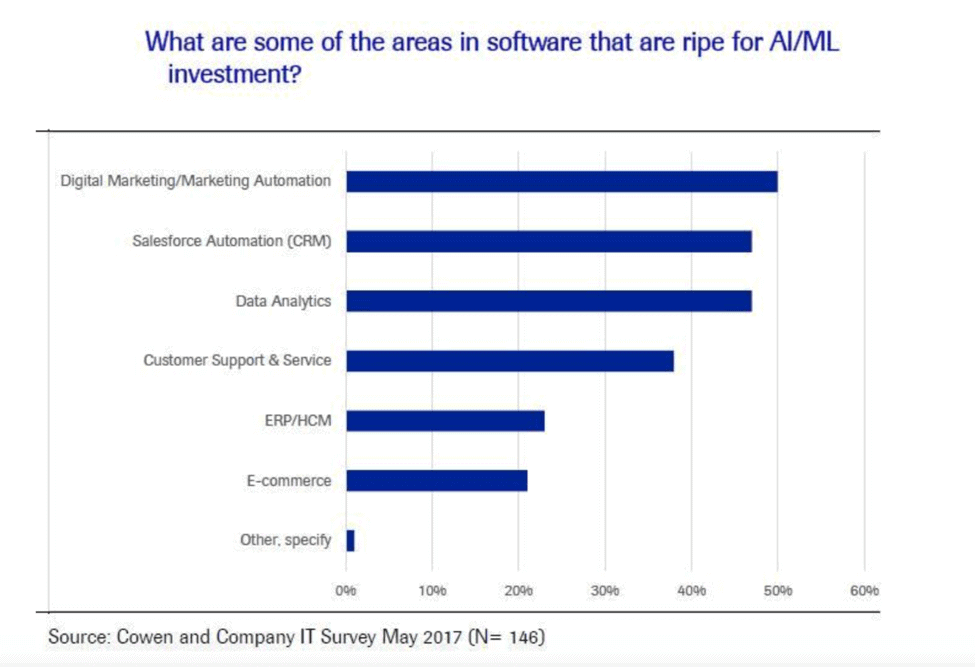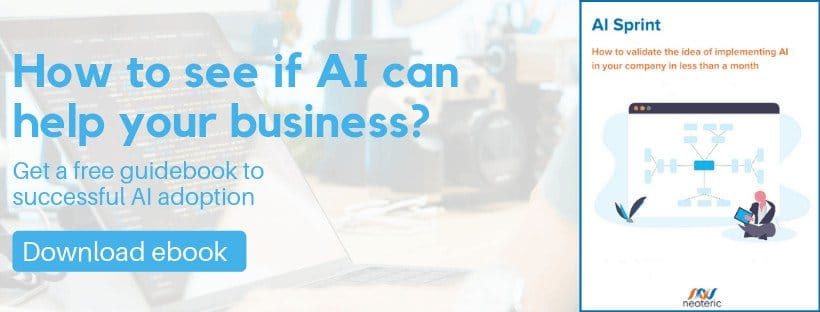When you already know that artificial intelligence is creeping into every area of business, it’s no surprise that e-commerce can make use of it as well. Many e-commerce businesses are already using artificial intelligence development services to better understand their customers, generate new leads, and provide personalized customer experience.

The same question comes up every time we talk about artificial intelligence: is it going to take the jobs of online retailers? And again, the answer is no. Artificial intelligence is used to support the sales team, automate the tasks that are mundane and time-consuming and channel the efforts of real people towards the tasks that are more ambitious. AI is not a replacement of real people. Simply put, it is there to assist us in many tasks, and it is often even better than us at those. When we think about e-commerce business, it’s all about sales 24/7. The customer chooses when and where they want to buy something. It may be a Friday night, early morning, or even Christmas Day. The service is available whenever they need it. Artificial intelligence in e-commerce enables companies to collect and process data in realtime – and not only does that help increase sales, but it also provides a better, more personalized customer experience.
Why do we need artificial intelligence in e-commerce?
Think about a shop, a pharmacy, or even a gym open 24/7. There’s always someone there. We need places like that, we want services and products to be available whenever we need them but, at the same time, we know that some person has to work early in the morning, at night, or even during Christmas. E-commerce sites are available 24/7 but they don’t require a shop assistant to be online all day round. There are chatbots that can do that. Simple questions are answers right away, more complicated ones are forwarded to the right specialist, while the customer receives some answer right now. And “right now” is of utmost importance here – people shop online because they want the online shopping experience to be effortless and quick. You add an item to your cart, pay for it, receive it as soon as possible. If a problem occurs, you want it solved right now as well. If you want to wait a few hours or days for a response, you may just as well go to a shop yourself.
Artificial intelligence and machine learning are also extremely valuable when it comes to customer data. Having a lot of customers, you also have a lot of data about what they buy, when they buy it, etc. Though at first sight such information doesn’t have to make much sense, believe me, it so does. Machine learning algorithms analyze data to find patterns and predict users’ choices. That’s how you learn what your customers will want to buy next. Smart move, isn’t it? It gives your users a personalized customer experience thanks to accurate recommendations and helps your company increase sales.
It has been estimated that by 2020, customers will manage 85% of their relationship with the enterprise without interacting with a human. 2020 is not that far away, and if your company is not keeping up, well, quite obviously, it’s falling behind. Big players like eBay and Amazon rely largely on artificial intelligence. That has to mean something.
What are the benefits of artificial intelligence in e-commerce?
Let’s go through an updated list of not six, but nine amazing ways to use AI in e-commerce.
Customer-centric search
As a shopper, I can tell you that if I try to shop online and search for a phrase and I don’t like the results I see, I’m going to leave. I’m not the only one. Amir Konigsberg, the CEO of Twiggle, confirms that users often abandon e-commerce experiences because the search results displayed are irrelevant. Artificial intelligence or, to be more accurate, natural language processing, comes to the rescue. NLP helps narrow search results to find the most relevant results.
But that’s not all there is to search engines. Comsore estimates that by 2020, 50% of all searches will be voice searches. It is also estimated that by 2021, the early adopters that implement visual and voice search into their websites will increase e-commerce revenue by 30%. Voice search is on the rise and it poses new challenges to businesses, but I also mentioned visual search. What about that? Is it something worth paying attention to?
Once again: search results must be relevant. For years, search engines have used metadata and tagging to identify the right images. It was often done manually. Artificial intelligence automates the process of image classification and product tagging to make sure that search results are accurate. And with AI, the images themselves are a data source that allow to precisely identify attributes of products, which then leads to better search results.
Now let’s think about what the user does with a picture. Let’s say Mike sees a navy backpack with a wolf print on it. Somewhere on a picture, he has no idea where to find it, but he likes and wants to investigate. The process of googling the phrase “navy backpack with wolf print” and then going through the results to find the exact same item and the image source is quite complicated comparing to just dragging and dropping the image into the search engine and being given results of items identical, or at least very similar, to the one he’s seen. This way Mike learns that his backpack is sold by company ABC and he visits their website.
Pinterest introduced their visual search tool back in 2015, writing:
Sometimes you spot something you really love on Pinterest, but you don’t know how to find it in real life, or what it’s even called. There’s that perfect lamp hiding in a Pin of someone’s living room, or maybe a random street style shot with the exact shoes you’re looking for.
Their tool allows users to search for images similar to the one they like and learn about the details of items in the pins. Zooming in on an item, you see what it’s called and where to find it. You no longer have to come up with long, descriptive phrases hoping that it will work and give you the right results.
But visuals are significant in one more thing: visual listening. Visual listening allows brands to find in-photo mentions. You can now see all the images and videos related to your brand, not only those that tag it. According to Brandwatch, 80% of photos of products shared by consumers don’t include a mention of the product or brand in the text. With AI, it’s not a problem anymore since brands can now collect all the data in an automatic way.

Personalized recommendations
I’ve already taken on the topic of recommendation engines in my article about artificial intelligence in customer service (read more here). Artificial intelligence is capable of analyzing customer behavior on websites and process big data. The data collected this way helps identify patterns and then accurately predict what a given customer will want to buy next.
AI can accumulate data about the customer’s previous purchases, conversations with customer service, on-site customer interactions, and many more. All these lead to personalized customer experience – and that’s what makes your customers happy. Plus, your sales go up. It’s a win-win situation, isn’t it? There are numbers that prove it’s true: think Amazon and Netflix. These companies were one of the early adopters of AI-driven personalized marketing strategy. Amazon a 29% increase of sales after implementing the recommendation system. Netflix says that 80% of content watched by their users is based on the algorithmic recommendations.
Responding to queries
Every once in a while a customer is going to ask you some question. Or perhaps they ask questions all the time. They do that because they need consultancy or assistance. But there’s one important thing that can drive customers away from your company: not getting a response in a short time. If your customers have to wait a day or two to get a simple answer, no wonder they’re not happy. The staff of your customer service is surely doing their best, but they just can’t answer a few messages at once. Artificial intelligence can shorten the response time.
Chatbots can handle some queries on their own: if the question is fairly simple, the system generates an answer that is relevant to the customer. If the question is more complex the bot will identify the right specialist to handle it and forward the message there. This solution speeds up the process of answering customer queries and allows for real 24/7 customer service that users expect.
Creating product descriptions
Writing product descriptions requires a copywriter, right? You would think so, but with hundreds or thousands of products available on the website, it would be quite a costly and time-consuming process. It’s not only about writing some content, the text has to be relevant and optimized for SEO. Artificial intelligence can analyze the key features of each product to create descriptions by itself.
Filtering fake reviews
You should never underestimate the power of reviews, especially if they’re negative. According to Dimensional Research, 90% of customers say that their buying decisions are influenced by online reviews, while 86% say that their decisions are influenced by negative reviews. Unfortunately, not all reviews are real: some can be posted by competitors, haters, or even bots. How can you solve this problem and avoid losing customers due to fake reviews? Amazon uses artificial intelligence to fight such reviews. The system boosts the weight of verified users’ reviews, those marked as helpful by other customers, and more up-to-date reviews.
Analytics & predicting sales
We already know that AI can accumulate data, study patterns, and predict things. Artificial intelligence in e-commerce allows to track incidents in real-time metrics extracted from both internal and external sources. AI enables receiving notifications about dips in sales due to competitor behavior, about third-party API errors that impact transactions, or about page latency problems or errors causing higher cart abandonment.
There’s also predictive analytics. It analyzes historical data and projects future outcomes.
AI helps manage inventory: Walmart uses it to predict which products are likely to sell out and which underperform. This helps the managers stock appropriately and decreases the risk of making costly adjustments later.
Though it may seem to be some sort of magic, forecasting is much more than just fortune-telling; it’s science. AI uses data and facts to come to a conclusion, it doesn’t rely on gut feeling, and it’s neither optimistic, nor pessimistic. It’s accurate in its predictions. There’s always a data-driven explanation behind any number.

Preventing counterfeit sales
Counterfeit products comprise about 5 to 7% of all global trade. Counterfeits weaken a brand’s reputation and take away revenue by selling unauthorized goods to your customers. To put that into $ perspective: according to the Global Brand Counterfeiting Report 2018, the amount of global counterfeiting reached to 1.2 trillion dollars in 2017, and it is estimated that it will reach 1.82 trillion USD by 2020. Losses incurred by Luxury Brands because of sale of counterfeiting through internet accounted to 30.3 billion USD.
As the fake goods industry keeps on growing, many brands face a big challenge. And with internet sales, fakes are even more difficult to spot. Artificial intelligence can provide a solution. Computer vision and natural language processing can help brands organize information and spot fakes quicker. AI solutions can detect and remove online intellectual property infringements. Advanced keyword monitoring systems and image recognition help identify counterfeit products. Burberry is using image recognition to analyze details in the texture and weaving to identify counterfeit products with 98% accuracy. Thanks to that, they can quickly take action against companies offering fakes.
Price optimization
Dynamic pricing is a must for e-commerce retailers to increase sales and generate more profit. With machine learning, companies can monitor and adjust prices more effectively. To make accurate pricing recommendations and sales predictions, algorithms analyze historical and competitive data. Dynamic pricing can boost profits by 25% on average.
Amazon uses dynamic pricing and updates the prices of products 2.5 million times a day, which means that a product’s price changes about every 10 minutes as reported by Business Insider. How do they do it?
As described in the excerpt from “Swipe to Unlock: The Primer on Technology and Business Strategy”:
Amazon analyzes customers’ shopping patterns, competitors’ prices, profit margins, inventory, and a dizzying array of other factors every 10 minutes to choose new prices for its products. This way they can ensure their prices are always competitive and squeeze out ever more profit.
Connecting the online and offline
Online shopping keeps growing in popularity and fewer customers visit stores. Retailers are looking for ways to make the shopping experience exceptional in the real world too, and they’re doing that by connecting the online with offline. Retailers are often turning to artificial intelligence solutions to improve the in-store shopping experience. While collecting data on an e-commerce website is quite easy, data collection can be quite a challenge for a brick-and-mortar store. Companies such as Amazon, H&M, and Burberry combine online and offline data to provide exceptional shopping experiences for all customers.
So how exactly can you combine the online and offline worlds? Companies can encourage customers to share their data voluntarily through loyalty and reward programs. The data on purchase history helps provide relevant recommendations of products, both online and in store. In store, sales assistants can use data on the customers’ purchase history and social media activity to suggest certain products. For example, if the customer previously bought a coat, the assistant can offer a handbag to go with it – and it’s an informed suggestion based on what other customers buying the same coat chose, not just on the assistant’s gut feeling.
H&M has a recommendation system on their website and is now expanding that to the in-store experience: they’re introducing an RFID-powered “in-store mode” in the H&M app, which would allow the shoppers to explore products chosen for them in a given store.
Amazon Go convenience stores show how new technology can be integrated into retail space. It’s a checkout-free shopping solution where the customer uses the dedicated Amazon Go app to enter the store. Then all you have to do is grab the items you want to buy and go. No lines, no checkout. Every item you take from the shelf is automatically added to your virtual cart and payments are handled through the app. Amazon Go utilizes computer vision, sensor fusion, and deep learning algorithms to allow for this extremely convenient shopping experience.
Artificial intelligence in e-commerce: is it a necessity?
We’ve gone a long way without AI, so why would it be necessary now? There are numbers proving that AI-driven solutions help businesses increase sales, retain customers, boost customer satisfaction. Right now it’s still something relatively new but soon, you’ll be falling behind your competitors if you don’t use it. Why is artificial intelligence so good? Because it’s just brutally honest. It studies data and delivers results to show you actual numbers and facts about your company. And that’s exactly what business needs.


